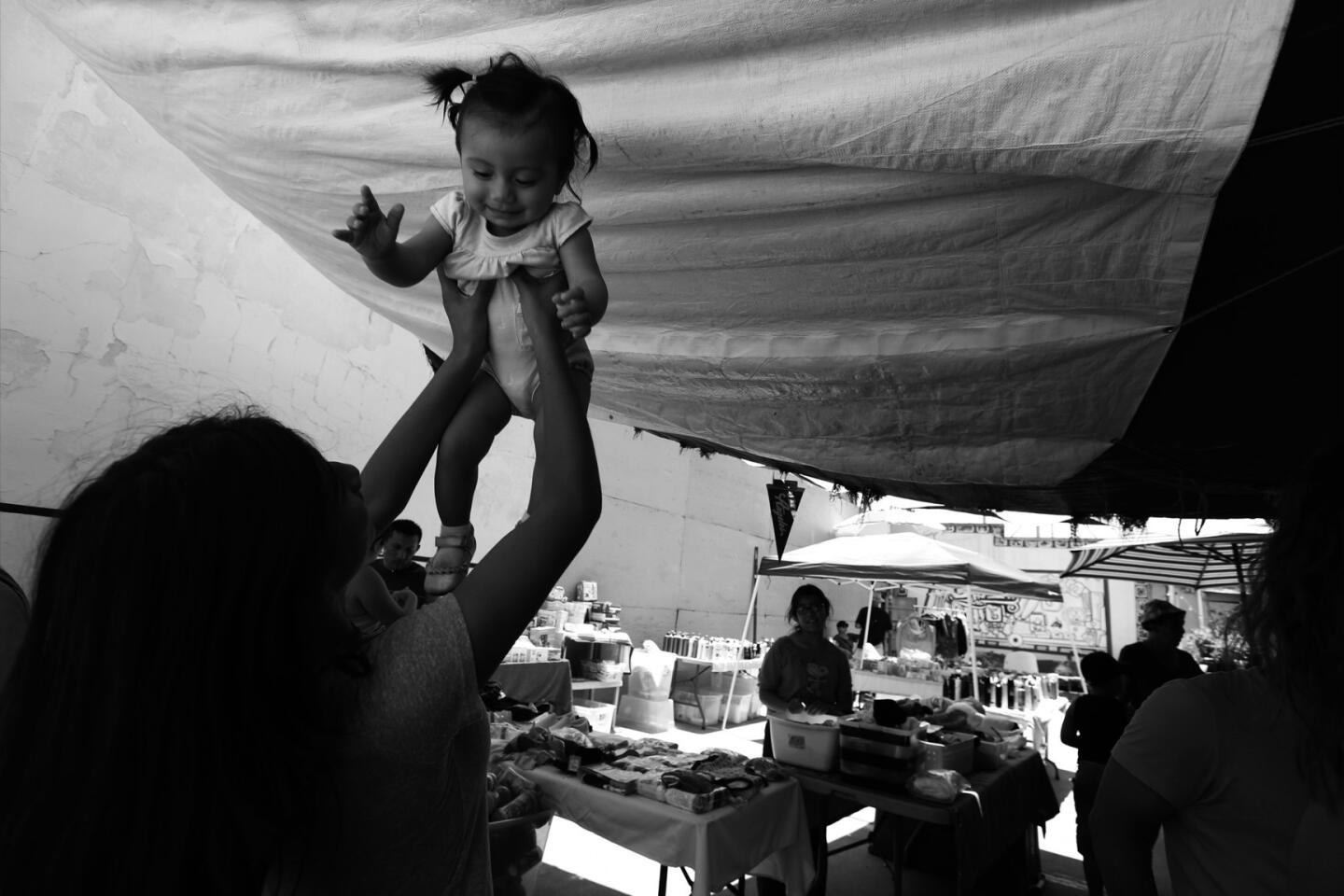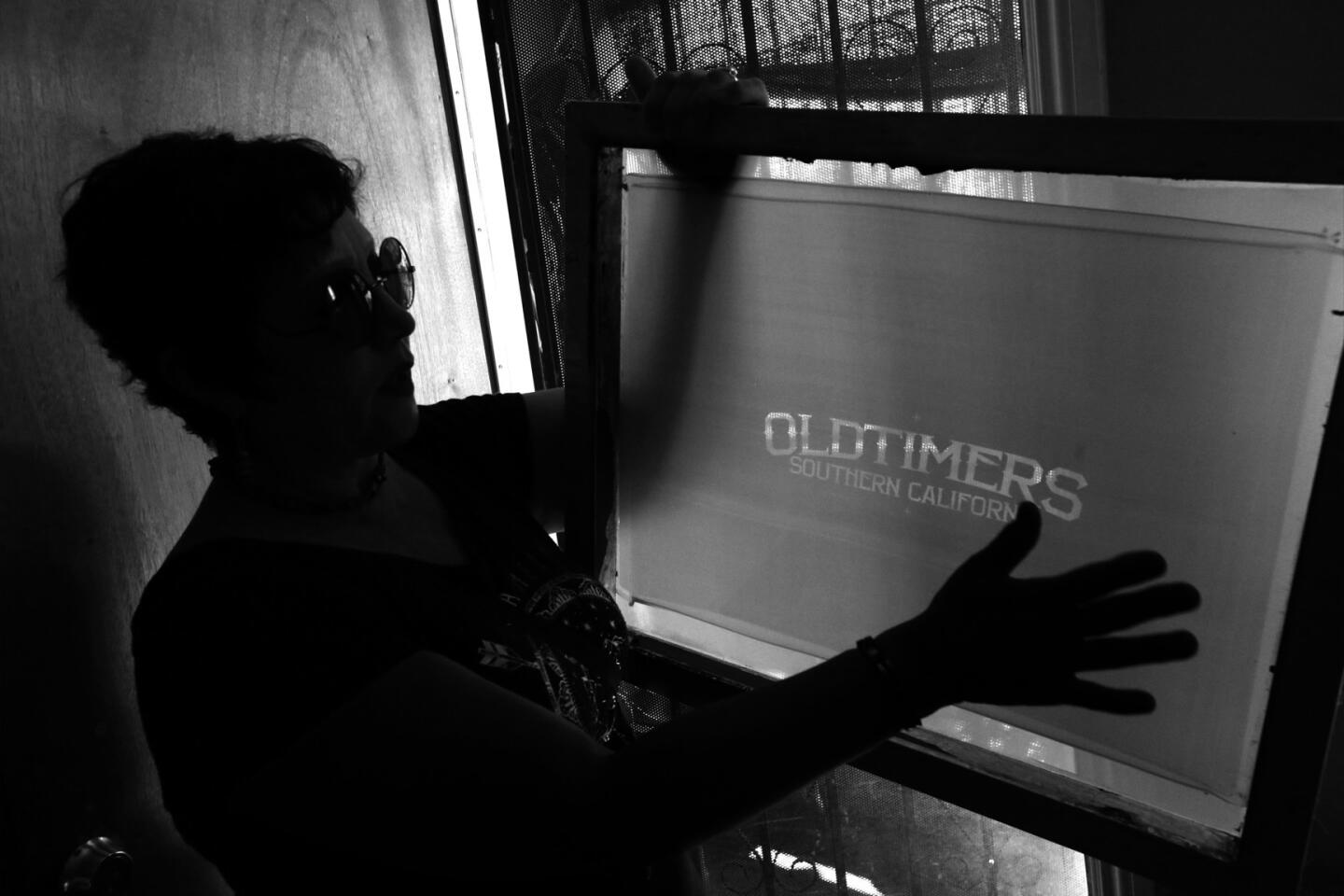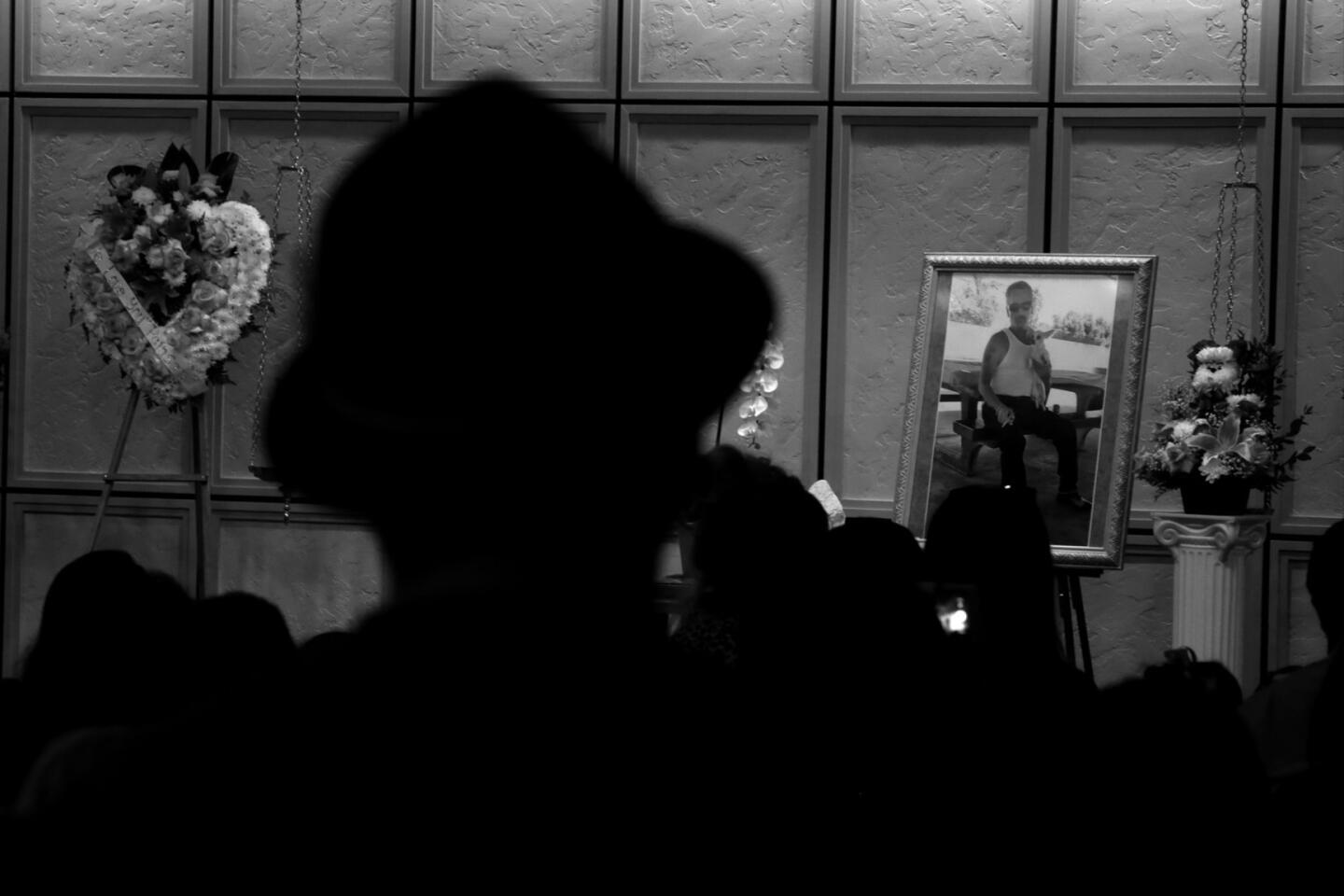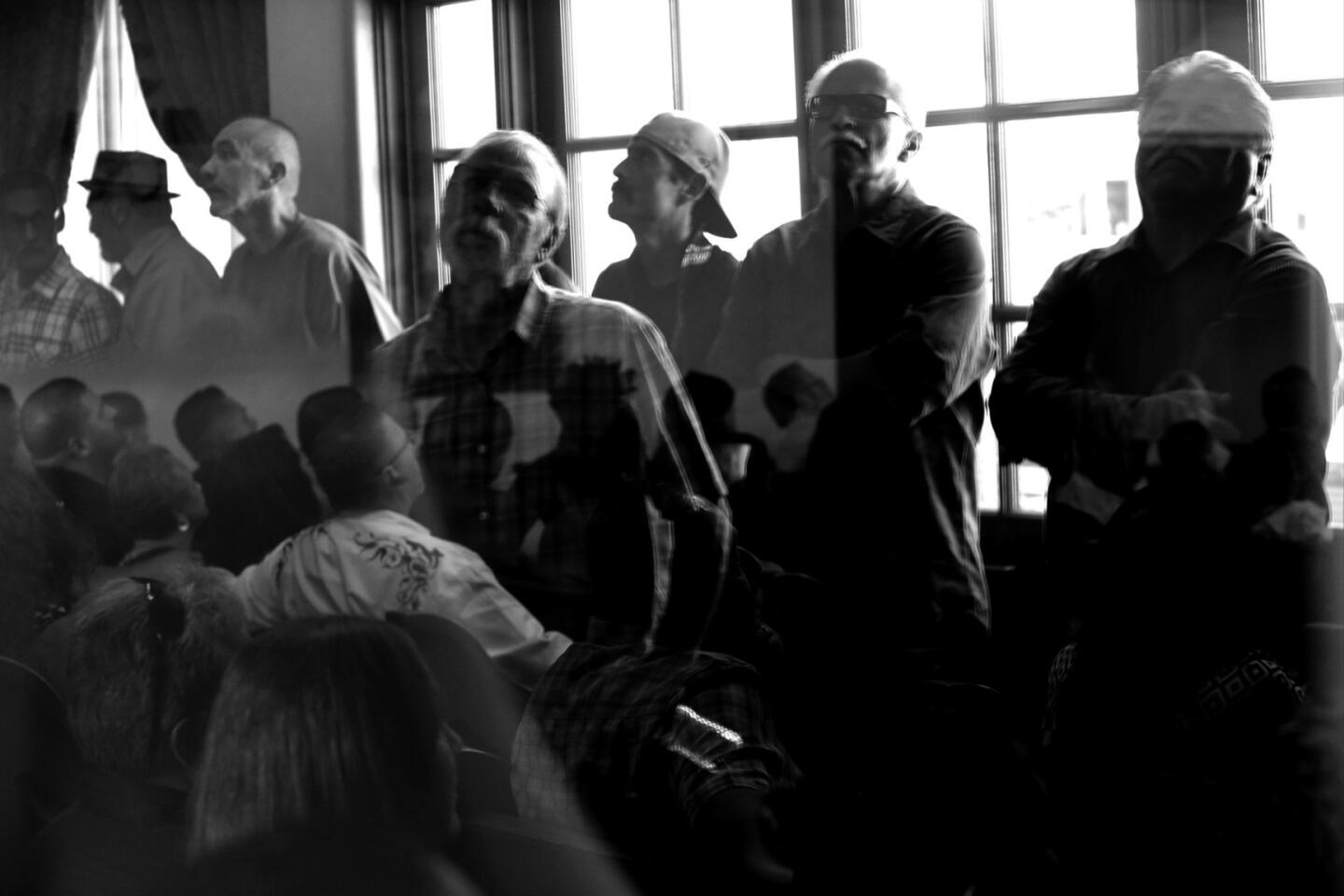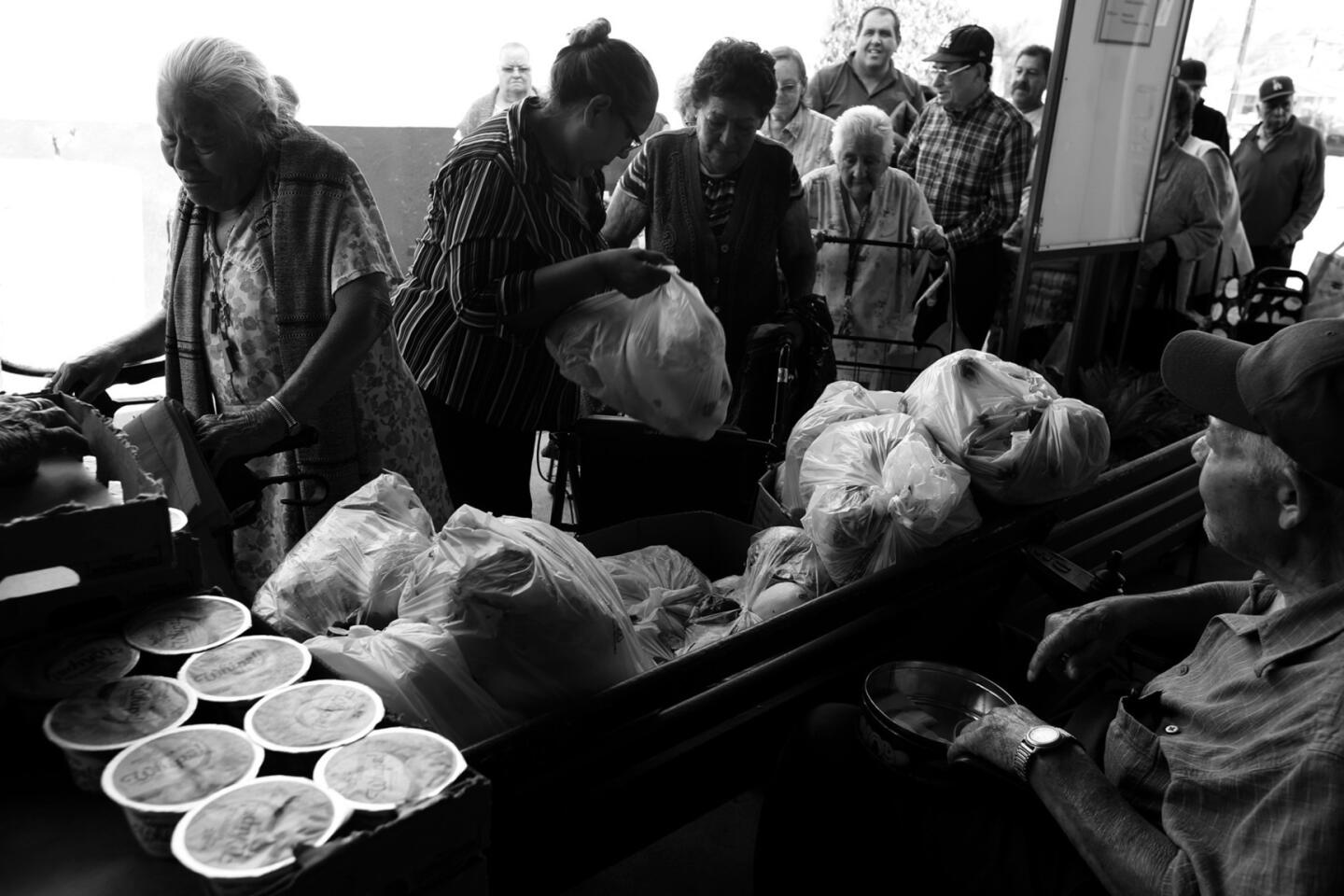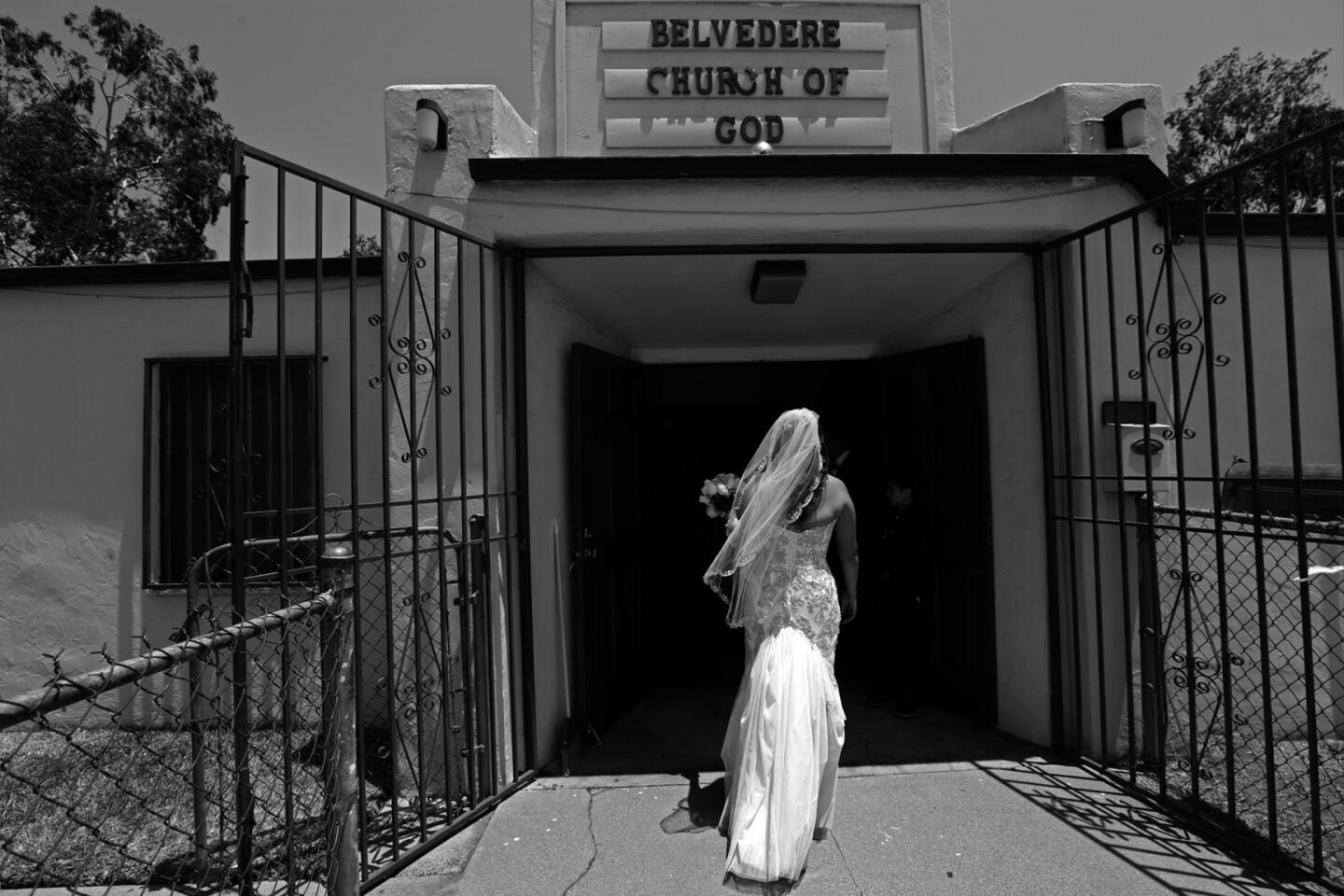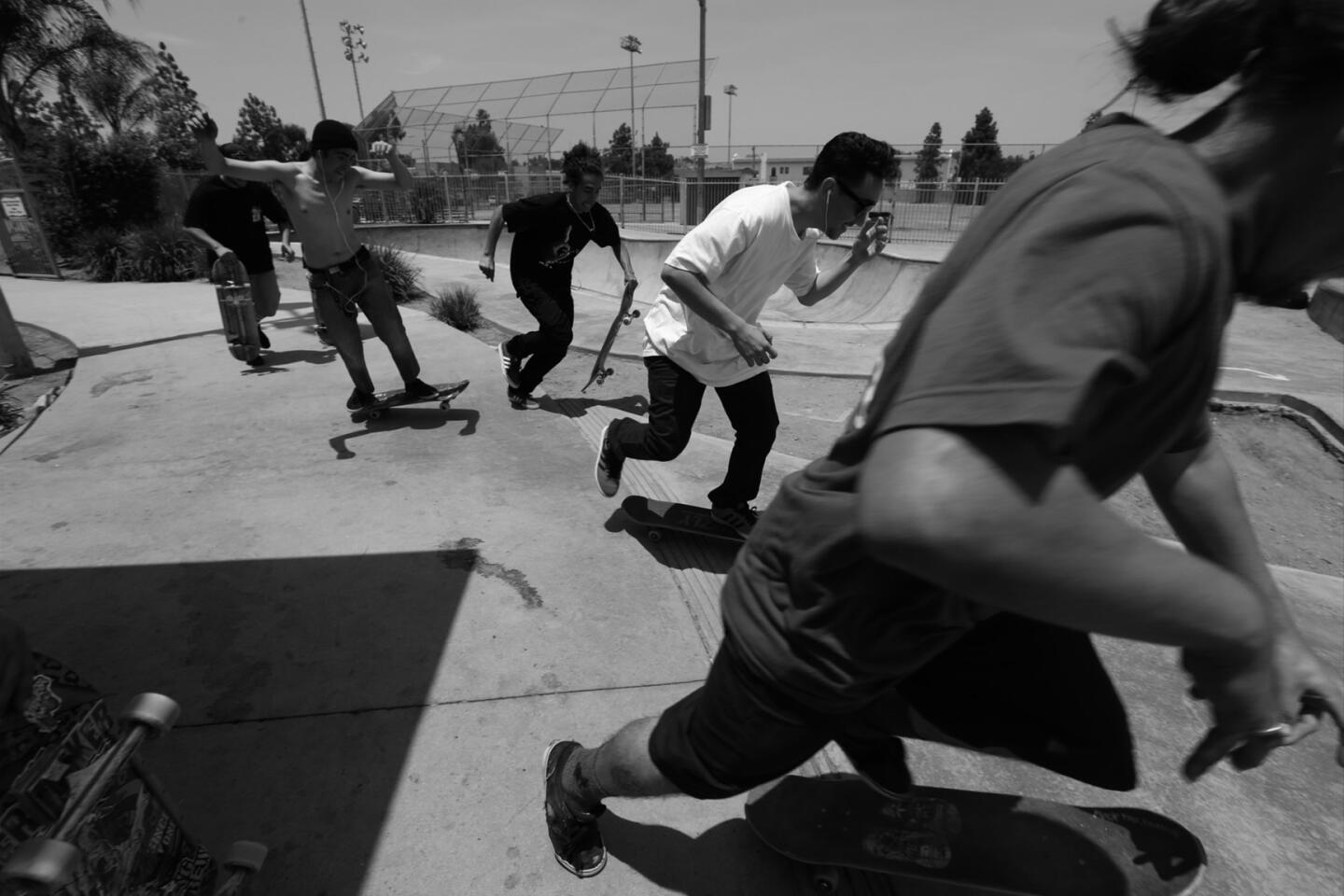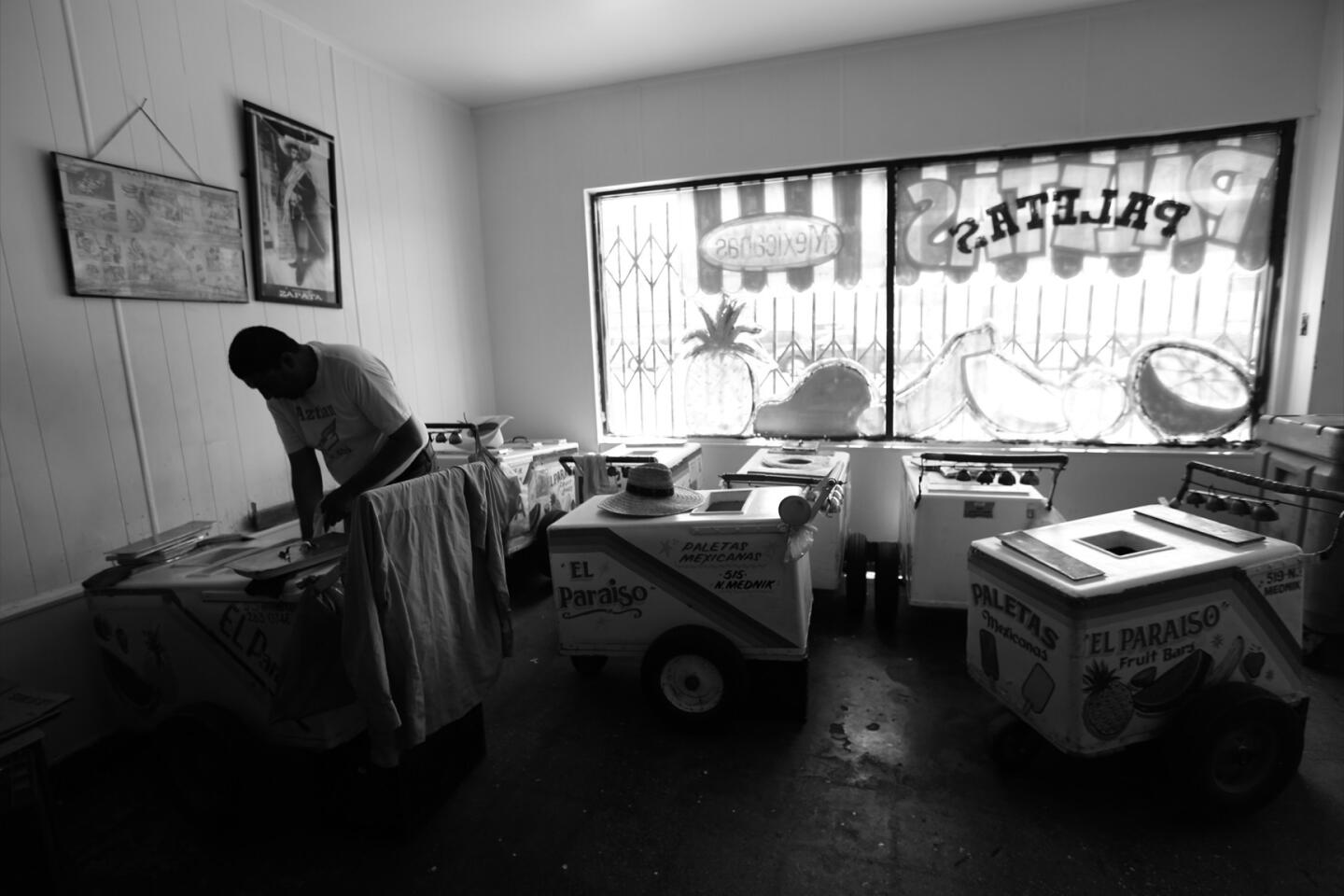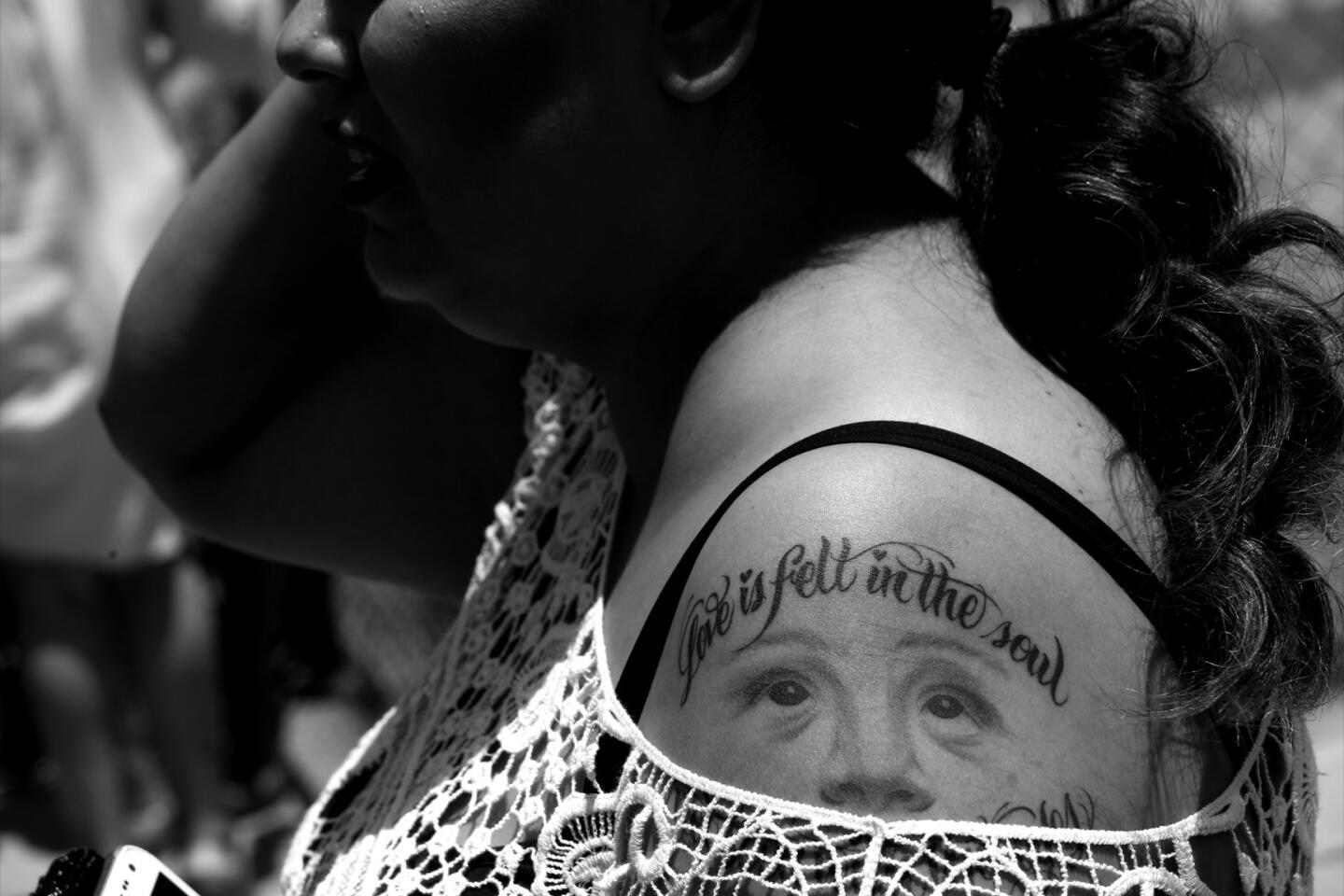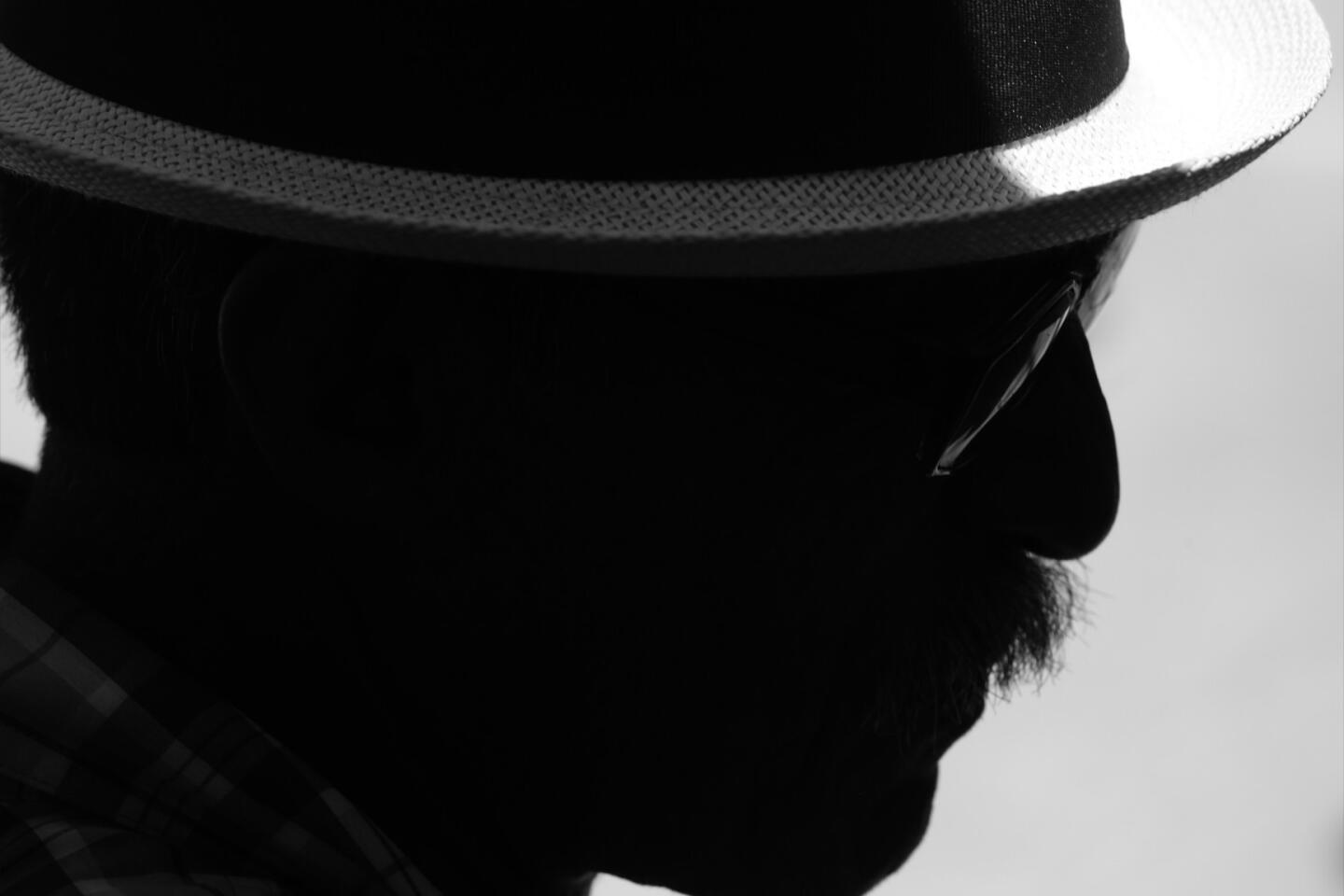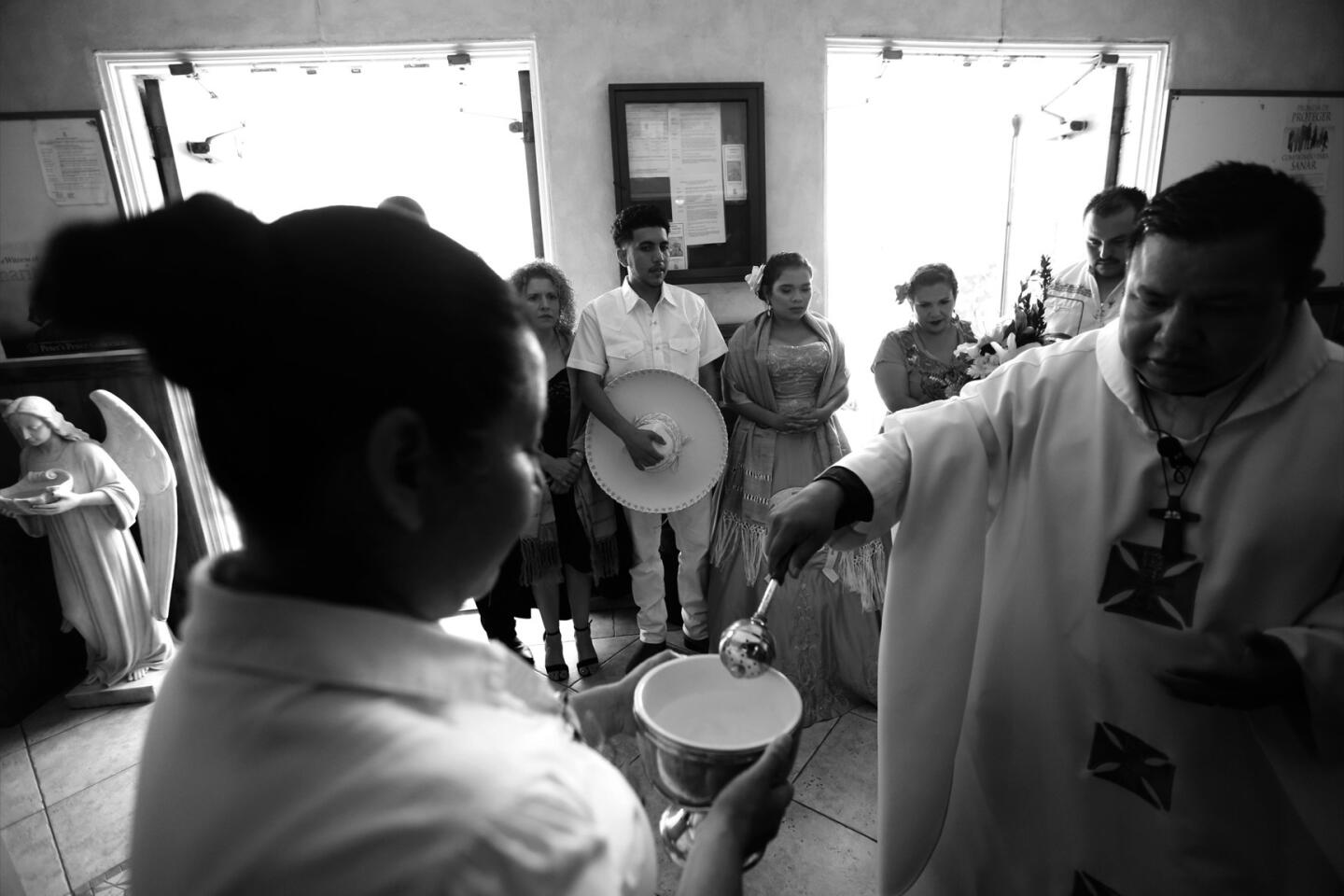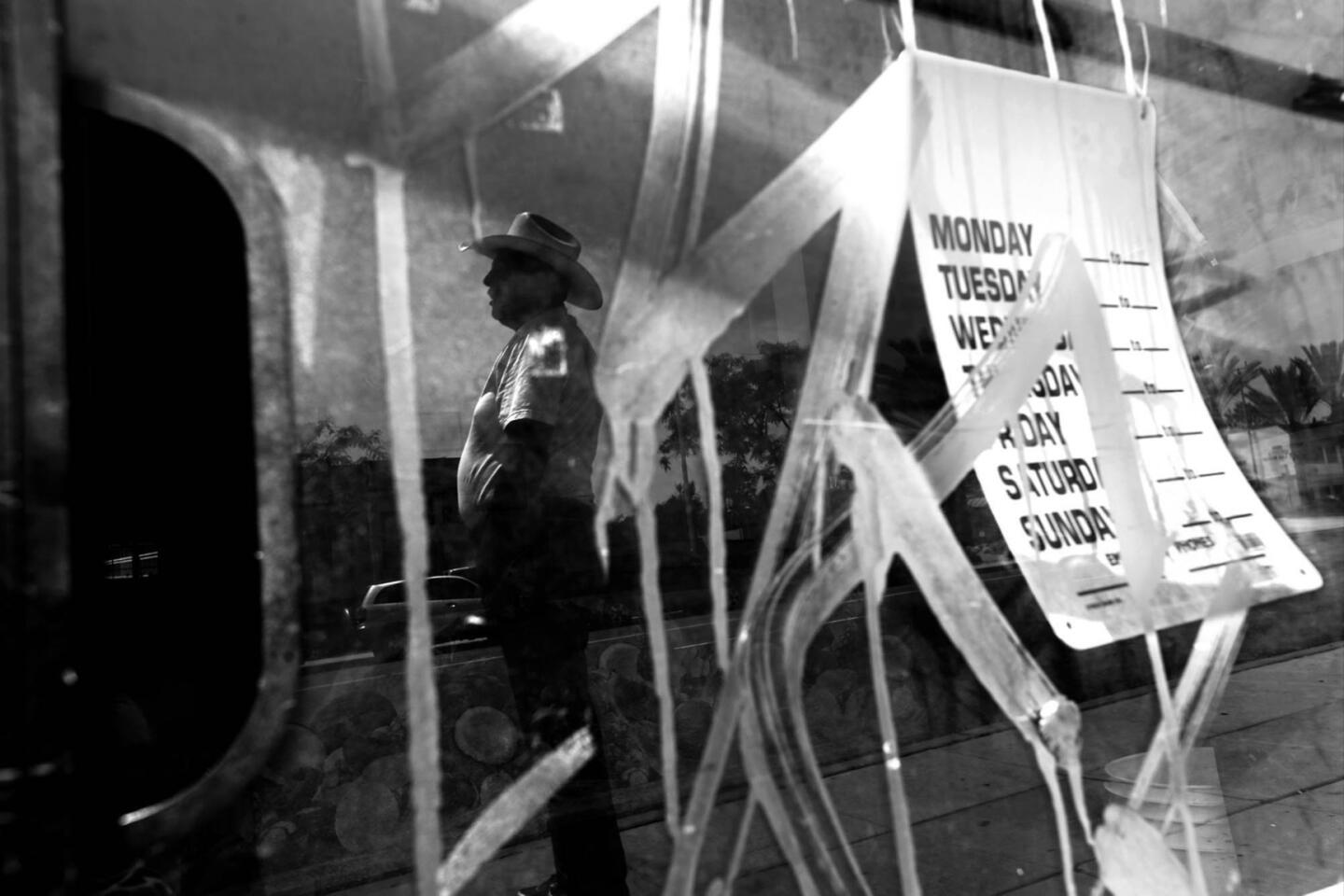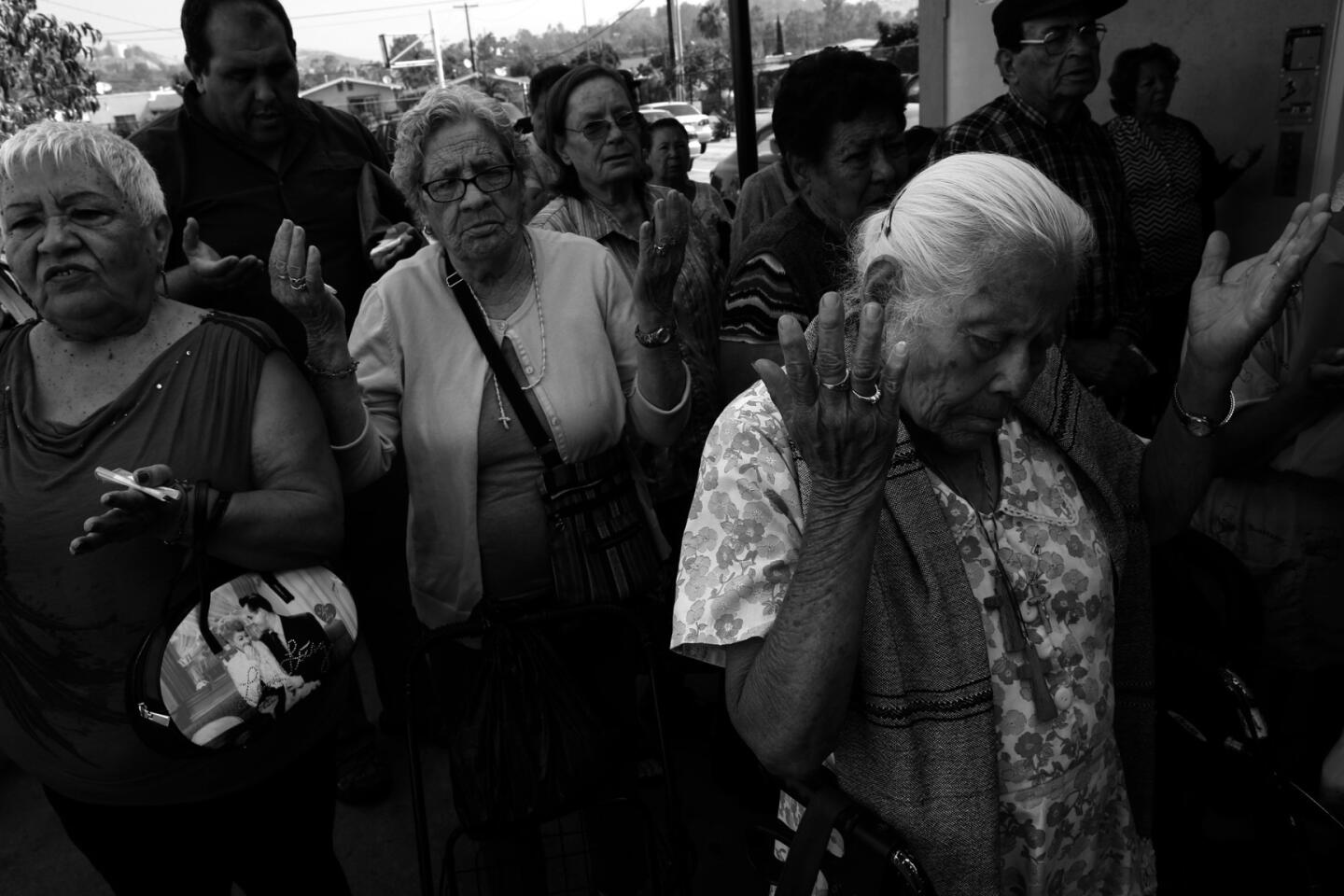So much has changed in East L.A. since 1928 -- but not handball
- Share via
Like a medieval fortress, the Maravilla Handball Court in East L.A. rises, improbable and imposing, above the wood-frame bungalows of its neighborhood and the stucco housing project across the street.
Thwop.
Its north wall is three stories tall, red brick etched by white mortar and surmounted by rusted chain-link and chicken wire. Its east wall slopes down from this height over the length of a half-block to a modest single-story corner market.
Thwop.
So wonderful are these ramparts that they seem less man-made than a natural feature of the landscape, leaving some passersby to pause and listen to the curious sound coming from the other side of the high walls.
Thwop.
For the initiated, this citadel north of Cesar Chavez Boulevard is no place of mystery, and the sound of a ball careening off a front wall — thwop — is an invitation to step inside.
On a Saturday afternoon, mid-July, one of the hottest days of the year, Eddie Reveles and Johnny Herrera are up against Freddy Reyes and his son. The Reyeses have the lead, but their opponents are ceding nothing.
Neither are the spectators, most of whom have stood up for this court through the years of uncertainty after the death, almost 10 years ago, of its beloved owners, Tommy and Michi Nishiyama.
They watch the match from folding chairs under pop-up canopies. Hot dogs sizzle on a grill. “Chain of Fools” play, play, plays through scratchy speakers.
They’ve come to the neighborhood of Maravilla from as far as Hesperia and Mojave, Azusa and Burbank, to hit a small rubber ball in what must be the oldest handball court in Southern California.
But age — the brick walls were raised almost 90 years ago — can be a liability in a community that’s easily overlooked. History in these unincorporated streets often is lost to more immediate concerns, like economic development.
“Ten serving six,” shouts Anthony Huante, the tournament’s scorekeeper and steward. The matches today are played in memory of his father, Tony Huante, one of Southern California’s most revered handball players, who died in December.
Growing up, the younger Huante, 58, preferred football to handball, but he wants to honor his father, who last year talked about buying this property.
Finding that kind of money, though, is not easy for someone who supports himself with odd jobs — selling sports jerseys, cleaning carpets, roofing, landscaping. Huante has enlisted the help of a friend and his sister and has an important ally in Amanda Perez.

For decades, the Maravilla Handball Court in East Los Angeles has been a refuge, welcoming outsiders who feel safe inside its walls.
::
Dressed for the heat wave in a sleeveless shirt that partially obscures traces of old tattoos, Perez is six days out of the hospital. Diagnosed years ago with hepatitis and cirrhosis — she makes no excuses for her hard-living ways — she’s now paying the price.
This has never been an issue of good and evil, about haves and have-nots.
— Bill Martinez, historical society member
For 10 years, she has been an advocate for the property, but her efforts have stirred up old divisions in the neighborhood. Harassed and tired, she lacks the energy to continue. She’s 60, ready to let someone else take over.
She grew up in Maravilla. Her mother bought groceries from the Nishiyamas, whose generosity was famous. Michi extended credit to customers, even lent her wedding dress to the girls who didn’t have one, and Tommy helped organize the court’s handball club. Perez remembers the one-dollar sandwiches Michi made with big cuts of baloney, salami and ham.
“I would walk by on my way to school and could hear sounds on the other side of the wall. It always pulled on me,” she said.
Perez moved to a neighborhood on the other side of the 710 Freeway, got married, got pregnant, tried to find her way out of addiction and incarceration, and eventually succeeded. A counselor for parolees, she brought meaning to her life helping others with theirs.
One day in 2008, she drove past the handball court and market and was surprised by what she saw: a shopping cart, a sofa and mattress parked on the sidewalk, someone living in the alley, condoms and drug balloons littering the ground. Plywood patched a hole in the market where a drunken driver had smashed his pickup.
“Who’s living there?” she asked her friends.
“No one,” they said. They weren’t counting the squatters.
“Then we ought to save it.”
She called the Nishiyamas’ son. Tommy Jr. had grown up here, watched his parents try to manage the property into their 80s, and now that he was living in Santa Ana with his family, he was eager to end his ties with the neighborhood.

He told her the property was in probate, but he made a deal with her. He would rent the market and the handball court for $500 a month with an option to buy, $350,000 for everything.
Perez agreed. They signed a lease agreement, and with friends from the newly formed Maravilla Historical Society, she went to work, evicting the squatters and hauling away at least 30 truckloads of junk that had accumulated in sheds, the market and the small bungalow adjoining the court.
They painted the high walls white, replaced the missing letters to a sign that proudly announced “MARAVILLA HANDBALL” and one night, past midnight, burned sage and drummed away lingering spirits.
But managing the property grew a little more difficult and expensive with each year. “It was like opening Pandora’s box,” she said.
In 2011, an electrical fire gutted the interior of the market. The tenant in the bungalow, who helped subsidize the lease, moved out, and Perez’s health began to act up. She found herself having to scrape up the money for rent.
Tommy Jr. eventually accepted $300 a month. He had other offers, but he trusted Perez.
::
The L.A. County assessor first recorded a handball court on Lot 44 in Maravilla Park in 1928. Joe Magelleney owned the property.
At the time, East L.A. was a far-flung quarter of this city. Street names — Arizona, Ventura, Chicago — added a note of familiarity, but Presbyterian missionaries, venturing up Ford Avenue to Brooklyn Avenue, three blocks away, found a wilderness, homes built of piano boxes, discarded lumber and roofed with kerosene cans.
It was, from the missionaries’ perspective, “a wretched, discouraged-looking mess of things,” a place for refugees, escaping the civil war in Mexico, the Dust Bowl and the prejudices that had swept through the country on the wave of exclusionary laws and immigration restrictions.
With help from his neighbors, Magelleney built the handball court from bricks that had been fired in the nearby kilns operated by Nathan Davidson, a Russian Jewish immigrant.
The design was rudimentary: one court, two primary walls. Oil drums, filled with concrete, formed the foundation of the north wall, which rose 28 feet. The east wall paralleled the street for more than 60 feet.
Later came a grocery store — the El Centro Market — anchoring the street corner, and beside that, a tiny bungalow, tucked into the remaining space on the lot.
Records show more than half a dozen owners, but none left as lasting an impression as Shigeru and Michiye Nishiyama.
They had arrived in separate ships from Japan on the eve of World War II. He avoided the camps by heading east and finding field work. She was 16 and was interned in Minidoka in Idaho.
They met after the war, moved to Los Angeles, raised two children in the home that adjoined the one-room market and watched, according to son Tommy, as violence in the neighborhood ratcheted up, from brawls to drive-bys, in the course of 40 years.
Neighbors grew more segregated as Maravilla became a patchwork, created in part by a number of well-intended public works.
During the 1950s and ’60s, the Long Beach and Pomona freeways cut through these streets. A major housing project, first constructed during World War II, was torn down and rebuilt in the 1970s. A decade later, a developer built a corporate business center on 110 acres just a few blocks north of the handball court.
Residents had come to identify with the streets and blocks they lived on: Kern, Arizona, Mariana, Ford. Lote for one block’s empty lots, El Hoyo for another’s hole or ravine.
Outsiders called them gangs, a pejorative considered useful in summing up a perceived predilection for violence and drugs. But those who lived here saw instead families and allegiances sharpened by a divisive history.
“Neighborhoods claim these places as a form of ownership when traditional opportunities don’t exist,” said Bill Martinez, who has run gang intervention programs in the county since the 1990s. “Owning a neighborhood offers control for those who might not have anything to own, no house, no job.”
The handball court, however, was a refuge, welcoming outsiders who felt safe inside its walls, and Perez tried to preserve its neutrality.
She and the historical society opened the court for fundraisers and a Saturday swap meet, for movie nights, art exhibitions, political lectures and Christmas and Day of the Dead celebrations. She also started research that in 2012 led to the property’s becoming a state historical landmark.
She wanted the court to become a center of local pride, not unlike El Gallo Bakery (favored for its pan dulce), Chuy’s Auto Electric Shop (the patent-holder for a charging system for automotive batteries), the Soledad Church (built in 1925) and a vacant lot called Windy Hill (where the ashes of friends and loved ones are scattered).
But Perez wasn’t alone in her ambition for the property. A contingent from the historical society took exception to her management style and tried to oust her. The fight got ugly. Vandals targeted the property, and Perez sought and won a restraining order to keep her safe.
“This has never been an issue of good and evil, about haves and have-nots,” said Martinez, a member of the historical society. “It’s have-nots versus have-nots. It’s a fight over the one thing in this community that could be turned into something positive.”
Still, Perez is hopeful.
“This place is a lighthouse,” she says, “and when a storm comes in, what does the lighthouse do? It gets brighter.”
::
By midafternoon, with temperatures rising above 100, shade is at a premium on the court.
“Bolle. Bolle,” says Freddy Reyes after winning another point. He doesn’t want to lose his momentum.
Only Torah, a resident pit bull with tiger eyes, has a different idea. She makes a break from the side yard where she has been locked up, runs onto the court and grabs the ball. Anthony Huante runs her down and wrestles her back inside.
Play resumes. Reyes holds the serve, leaving Reveles to struggle with a long shot that coasts impossibly close to the long side wall. He makes a stunning return, but Reyes follows with a shot that bounces perfectly off the short opposite wall.
“Sapo,” he says. Lucky.
The last point is over quickly when Reyes returns Reveles’ volley with a kill. The ball dies on the ground, and the match is over.
As the afternoon wanes, Huante calls the final matches while Perez sits inside the bungalow, feet elevated, a fan blowing air over her shoulder. She was in the hospital seven times in 2015, and earlier this year, she got a pacemaker.
She knows it’s time to hand over the place. The Metropolitan Transportation Authority is talking about running an elevated extension of the Gold Line along the street beside the court, and it worries her, a new division in the neighborhood. But that will be for others to fight.
Two weeks later, Huante makes his play. He offers $195,000. Nishiyama counters with $210,000.
Both parties agree. The sale is in escrow.
Near twilight, the tournament ends. Players grab their trophies, and as they leave the confines of the court, they pass beside an unfinished mural on the back wall.
Black and brown outlines depict the Aztec god Xolotl, the dog-headed man with lightning coming out of his mouth and the symbol of an ancient game, not unlike handball, played in the Americas long before the Conquest.
In flight, the ball is said to be the sun, and Xolotl is its guide. Today, he lends his allure to this hallowed place.
Twitter: @tcurwen
ALSO
Car-free festival CicLAvia — and road closures — in downtown Los Angeles
U.S. appeals court upholds law that requires religious clinics to inform women of abortion options
Forget the boot. Latest tool against parking scofflaws is the Barnacle, and it won’t let go.
Why Silicon Valley is pouring money into efforts to repeal California’s death penalty
More to Read
Sign up for Essential California
The most important California stories and recommendations in your inbox every morning.
You may occasionally receive promotional content from the Los Angeles Times.

